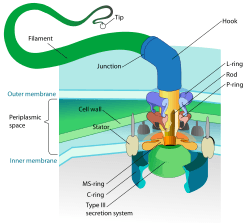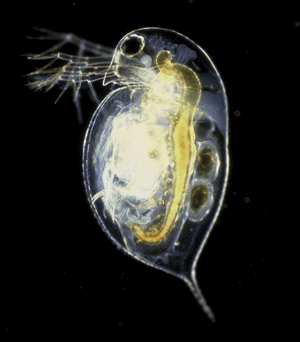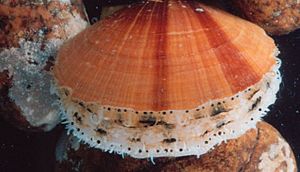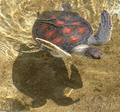Aquatic locomotion facts for kids



Aquatic locomotion is how animals and other living things move through water. Most of our planet is covered in water, and all the main groups of animals first appeared in the water.
Even animals that later evolved to live on land have often returned to the water. They usually still breathe air, but they live in the water. You can find aquatic insects, reptiles, mammals, and birds.
Moving around is important for finding food, finding the right places to live, and escaping from predators. Almost all advanced life forms, and many simple ones, use some way to move.
Contents
How Animals Move in Water
Tiny Creatures
The simplest ways of moving in water developed in microorganisms, which are tiny living things. They use special hair-like structures called cilia and flagella.
- Cilia: Some tiny organisms, like ciliates, have hundreds or thousands of small cilia. These cilia beat together to push the organism through the water.
- Flagella: Other organisms, such as bacteria and animal sperm, have one or more longer, whip-like flagella that spin or wave to move them through liquid.
Swimming has developed many times in more complex animals. This includes arthropods (like crabs and insects), fish, molluscs (like snails and squid), reptiles, birds, and mammals.
Water Movement for Invertebrates
All aquatic invertebrates (animals without backbones) swim at some point in their lives. Many of them swim for their entire lives.
- Jellyfish: All jellyfish swim by pulsing their bell-shaped bodies. This pushes water out and moves them forward.
- Crustaceans: Animals like crabs and shrimp (which are crustaceans) use their legs to swim.
- Molluscs: Some molluscs swim their whole lives, while others only swim when they are young larvae.
- Squid and Octopuses: Squid and octopuses move very fast using 'jet propulsion'. They suck in water and then squirt it out quickly to push themselves through the water.
Many insects live in water as larvae (young forms) or as adults. Most of them use their legs to swim. These insects breathe air and carry a bubble of air with them underwater. They get this air from the surface of the water and trap it among tiny hairs on their bodies. Many types of insects have aquatic stages, including all mayflies and dragonflies, and many beetles, bugs, and flies.
How Vertebrates Swim
Vertebrates are animals with backbones. Many vertebrates are excellent swimmers.
- Fish: Most fish swim by moving their bodies and tails from side to side. Their fins help them steer and balance.
- Some fish, like Atlantic bluefin tuna, are built for speed in open water. They have smooth, torpedo-shaped bodies and strong, forked tails.
- Other fish, like many reef fish, have flat bodies and use their fins for quick turns and movements around corals.
- The slowest fish, like sea horses, often live in reefs and move very slowly using a small fin on their back.
- Amphibians and Reptiles:
- Many frogs and toads swim by kicking their powerful hind legs.
- Crocodiles and alligators swim by moving their strong tails from side to side, while keeping their legs tucked in.
- Sea turtles use their front flippers like oars to push through the water.
- Birds: Many birds, like ducks and penguins, are great swimmers.
- Ducks use their webbed feet to paddle through the water.
- Penguins use their strong, wing-like flippers to "fly" through the water.
- Mammals: Many mammals have returned to the water.
Images for kids
-
A eurasian coot swimming
-
Shrimp paddle with special swimming legs (pleopods)
-
Open water fish, like this Atlantic bluefin tuna, are usually streamlined for straightline speed.
-
Many reef fish, like this queen angelfish, have a body flattened like a pancake for good manoeuvrability.
-
The leopard shark angles its pectoral fins to control its pitch
-
The slowest-moving fishes are the sea horses, often found in reefs
-
Nile crocodile (Crocodylus niloticus) swimming
-
Immature Hawaiian green sea turtle in shallow waters
-
Chinstrap penguin leaping over water


















